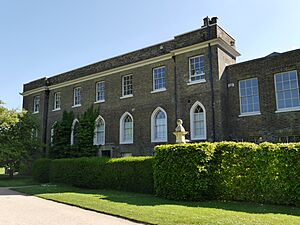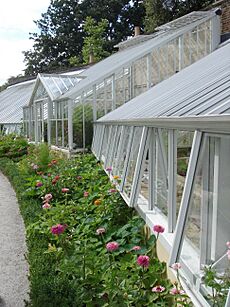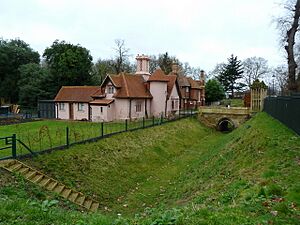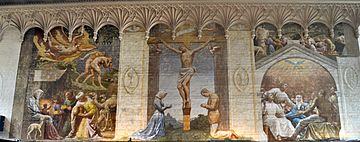Fulham Palace facts for kids
Quick facts for kids Fulham Palace |
|
|---|---|

The Tudor courtyard at Fulham Palace
|
|
| General information | |
| Type | Bishop's palace |
| Architectural style | Tudor, Gothic, Georgian |
| Location | Fulham |
| Town or city | London, SW6 |
| Country | England |
| Coordinates | 51°28′14″N 0°12′58″W / 51.470556°N 0.216111°W |
| Current tenants | Fulham Palace Trust |
| Owner | Church of England |
| Technical details | |
| Structural system | Brick, stone, wattle and daub, timber |
|
Listed Building – Grade I
|
|
| Designated | 7 May 1954 Amended 11 November 1988 |
| Reference no. | 1286903 |
| Designated | 1 October 1987 |
| Reference no. | 1000133 |
| Official name: Fulham Palace moated site | |
| Designated: | Legacy |
| Reference #: | 1001964 |
Fulham Palace is a super old building in Fulham, London, right by the River Thames. For over 1,200 years, from the 8th century until 1973, it was the main home for the Bishop of London. Imagine living in the same house for centuries!
Today, Fulham Palace is still owned by the Church of England. It's looked after by the Fulham Palace Trust, which is a charity. You can visit many restored historic rooms and a museum that tells its long story. The palace also has a huge botanical garden that's really special.
The palace is open every day, and it's completely free to visit. In 2015/2016, over 390,000 people explored Fulham Palace, showing how popular it is!
Contents
A Look Back: Fulham Palace History
Fulham Palace has a fascinating past, stretching back thousands of years.
Ancient Times: Before the Romans
Archaeologists have found tools made from flint, showing that people lived here as far back as 6,000 BC. This was during the late Mesolithic and early Neolithic ages. The area was likely a small island in the River Thames. There's also some evidence of activity during the Bronze Age and a little bit from the late Iron Age.
Roman Life: AD 43–AD 410
After a quiet period, people returned to the site during the late Roman period. They found everyday items, suggesting a small farming community lived by the Thames. It might have been a Roman villa near the current All Saints Church, Fulham.
Saxon Era: AD 410–1066
Not much evidence of Saxon life has been found directly at Fulham Palace. However, the land, known as the Manor of Fulham, was acquired by Bishop Waldhere in AD 704. This huge estate covered a large part of what is now West London.
Medieval Times: 1066–1485
The earliest sign of a home at Fulham Palace is a fireplace from around 1080. This was probably part of an early manor house. The first time a Bishop of London was recorded living here was in the 12th century. The medieval palace was built around what is now the eastern courtyard.
In 1439, King Henry VI and his group visited the palace. It took four days to clean up after they left! Workers also repaired the roof and fences, and a new bucket was bought for the well, which was built in 1426.
Tudor Transformations: 1485–1603
Big changes happened in the late 1400s. The amazing Great Hall and the Tudor courtyard, which you can still see today, were built. It's thought that Bishop Thomas Kempe started this work around 1480, and Bishop Richard FitzJames might have continued it. The oak timbers in the Great Hall roof were cut in 1493, and the gate timbers in 1495. This means Bishop Richard Hill likely oversaw much of this building.
A Mix of Styles: How the Palace Changed
Over hundreds of years, Fulham Palace was updated many times.
- The west courtyard is from the Tudor Period.
- The east courtyard has a Georgian look.
- The Great Hall is from the late medieval period.
- Parts of the building were updated in the Gothic style in the late 1700s.
- The east courtyard was given a classical makeover in the early 1800s.
- The 'Tait chapel' was built in 1867 in a Gothic Revival style.
World War I and II Impacts
During World War I in 1918, parts of the palace grounds were used as allotments. This helped grow food for the country during the war. The palace itself became part of a military hospital.
In World War II, bombs damaged parts of the palace. After both wars, it became very expensive for the church to keep up such a large building. In 1973, the church authorities finally moved out of the palace.
Fulham Palace Today: A Place to Explore
After the Bishop of London left in 1973, the local council leased the property in 1975. The idea was to open a museum and art gallery. For a while, the palace and gardens were a bit neglected. But in 1990, a special trust was created to look after the property with the council.
The palace grounds used to be huge, over 30 acres, but today about 13 acres remain. Even though the palace has its own chapel, its garden is next to All Saints Church, Fulham, where several past bishops are buried. The allotments from World War I are still used by local people to grow their own food and flowers!
You can still see some very old trees at Fulham Palace, including a 500-year-old holm oak. There's also a beautiful knot garden and wisteria in the walled gardens.
Restoring the Palace and Gardens
A big project to restore Fulham Palace began in the 2000s. It happened in three main stages:
- Phase one (2006): Restored the east wing and part of the west wing, including the Tudor courtyard. This cost £4 million.
- Phase two (2011): Focused on the walled garden, other buildings, and the moat. This cost £7 million.
- Phase three (2019): Included a new museum and major repairs to the brickwork in the Tudor courtyard and Great Hall.
All this amazing restoration work was funded by the National Lottery Heritage Fund and the Fulham Palace Trust. Fulham Palace is a Grade I-listed building, meaning it's very important historically. Many other structures on the property, like the chapel and moat bridge, are also listed.
The Palace Moat: A Mystery Ditch
The palace has a moat that is almost 1.4 kilometers long! It was the biggest moated site for a home in medieval England, but no one knows exactly when it was built. The first mention of it was in 1392, where it was called a "great ditch."
Because it's quite far from the palace, some people think it wasn't just for defense. One idea is that the Danes built it to protect against flooding from the Thames.
The moat was filled in during the 1920s. But guess what? It still exists underground as a complete circle! In 2010, archaeologists started digging up parts of the moat as part of the palace's renovation.
The Palace Garden: A Botanical Treasure

The garden at Fulham Palace has been a very important botanical garden since the 1500s. It's actually the second oldest in London! Bishop Edmund Grindal (who lived from about 1519 to 1583) created a Tudor walled garden. He's even credited with bringing the tamarisk tree to England and grew grapes for Elizabeth I.
Later, Bishop Henry Compton (1675–1713) introduced many new plants to England right here at Fulham Palace. These included the American magnolia and the first American azalea grown in England. He even grew the first coffee tree in England in his heated greenhouses! Famous gardeners like George London worked here. Bishop Compton also had a special friend, John Banister, who sent him drawings and seeds from America.
The Tait Chapel: A Place of Worship
The Tait chapel at Fulham Palace is the fourth chapel built on this site. It was designed by a famous architect named William Butterfield in 1866–67.
The chapel was damaged by a bomb in World War II. It was later reorganized in the 1950s. The beautiful mosaic artwork was moved, and a new window was added in 1956. The chapel also has amazing wall paintings that tell stories from the Bible.
Museum and Art Gallery: Discover the Past
In 1992, the Museum of Fulham Palace opened. It's located in what used to be Bishop William Howley's dining room and Bishop Porteus's library. The museum displays paintings, stained glass, and other items that tell the palace's history.
A very important book, Of Plymouth Plantation, written by William Bradford, was found in the library in 1855. This book is a key document about the founding of the United States! No one knows how it got there from America, but in 1897, it was returned to New England.
The palace also has a collection of interesting portraits, including works by famous artists like Benjamin West and John Hoppner.
Visiting Fulham Palace
The palace house and gardens are open every day, and entry is free! You can explore the museum and historic rooms. The beautiful walled garden is also open daily. The larger botanic garden is open from morning until evening. There's even a café in what used to be Bishop Howley's dining room, where you can grab lunch or a snack.
See also










